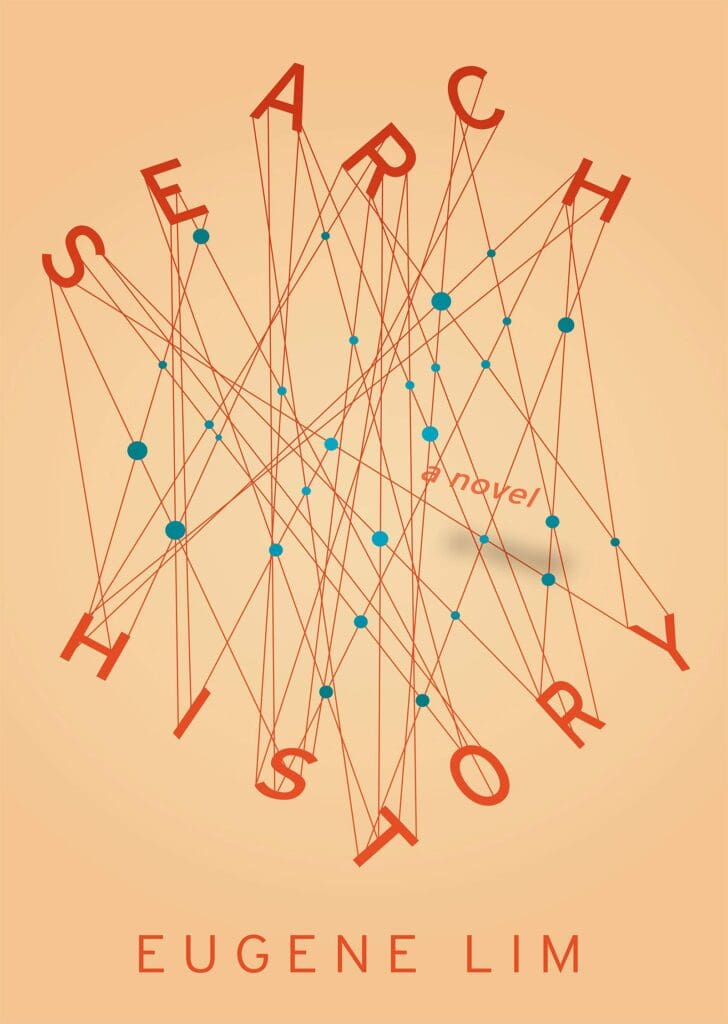If the art a society chooses to endorse is a measure of who and what it values, then it is also a measure of who and what it denounces. What is art, and who decides, are central questions in Eugene Lim’s latest novel, Search History (208 pages; Coffee House Press). The book is a metafictional examination of art and identity-making that is part action-packed speculative fiction, part autobiography, and part intellectual banter on all things art, race, technology, and death. Search History feels reminiscent of Douglas Coupland’s Generation X: Tales for an Accelerated Culture and the dialogue-heavy ’90’s films that inspired the mumblecore movement, like Richard Linklater’s Slacker. Unlike its vibey predecessors, which were comprised of mostly white casts, Search History confronts the white spaces where art and artistic discourse live—and pushes back against the way they have historically excluded people of color.
The novel begins with two characters in conversation at the opening of a supposed secret art collective named McArthur Grant, but which everyone knows to be a famous older white artist. At the gallery, the art consists of “White people in yellowface reading from the text of the Chinese Exclusion Act and transcriptions of ICE raid recordings.” The art is well-received but later the artist’s Chinese American girlfriend tells an interviewer that the yellowface performance had been her idea “to see how racist a piece the art world would accept.” In response: “The older artist denied this as well as the racism; instead, he claimed it was a transgressive gesture misunderstood by the self-elected tone police.”
Moments later the characters, including a robot and a famous documentary filmmaker, are transported to another time and place as different characters altogether—“Instead of being at an elite gallery opening in Chelsea, the fiction transforms them into two young women working under a fume hood, soldering bits under bright lights at a cell phone factory.” In this fashion, Lim suggests that the book you are reading is a metaphysical object. The narrative announces itself as a construct and the story names its conventions as they unfold before the reader. There is no illusion that the story exists without a creator.
In the less-plot driven sections of the book, Lim’s characters probe the meaning of art and existence through witty dialogue and philosophical musings over lunch at a place they refer to as Inauthentic Sushi. A major preoccupation of these conversations is who (or what) is capable of creating literature. The friends argue over whether a novel, particularly literature, can be composed by a computer. It is rumored that an AI scientist thinks she just needs to hit “the right combination of fifty-cent vocabulary, purposeful obfuscation, euro-fetishizing wistfulness, and saccharine plot” for the technology to produce award-winners. The notion of robots writing novels has been a controversial topic and one which Vauhini Vara recently examined in her personal essay “Ghosts.” In Search History, Lim uses the invention to further deconstruct the nature of dominant art in Western society—an art that is deeply exclusionary and markedly white.
“The idea of a novel isn’t very rigid. It’s all over the place,” an unnamed friend of the protagonist remarks during one of the lunch conversations, and appropriately, Search History is all over the place. Its alternating narrative tracks—which include the lunch conversations, a speculative-fiction buddy mission to find a runaway dog with the power to “appear to the grieving as the embodiment of their deceased,” and Autobiographical Interludes titled “Dead Friend”and “Mother”—are at times disjointed, but they never feel gimmicky or pretentious (which is often the pitfall of self-aware writing that grapples with the meaning of art and literature itself). The connective tissue of Search History’s multiple parts is of course art and identity but, more profoundly, grief and mourning the dead.
In the most plot-centered sections of the novel, the narrator comes to believe that their deceased friend, Frank Exit, has been reincarnated as a dog. A dramatic search for the dog ensues, and it becomes clear that Frank Exit is more than just a friend to the narrator—he is also a mirror. Although the narrator is Korean American, most of the spaces the narrator inhabits are peopled by white bodies. Frank reflects a version of the narrator that is otherwise absent—“the fact that we experienced the world through similarly marked bodies had rather outrageously turned out to be paramount to our friendship and indeed my very sense of self.” This ontological realization of needing to find self through another and the threat of its impossibility is a major crux of the book.
While Search History is a novel of big ideas about the relationships between art and technology, self and society, it is also a novel about the most quintessential human experiences—that we will lose someone we love and be forced to rewrite the world in their absence.

